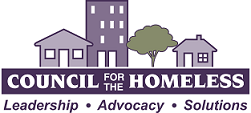By Kate Budd, Executive Director of the Council for the Homeless
The A, B, C’s of the 2019 Data
“If we have data, let’s look at data. If we all have opinions let’s go with mine.” Jim Barksdale
Collecting and analyzing data is an integral piece of any effective initiative, including reducing homelessness. Opinions and rhetoric, while helpful in giving context to data, are limiting when determining if progress is actually being made toward outcomes. Data helps everyone working toward desired outcomes understand what is happening as a result of the efforts and to make informed decisions. Data allows funders to measure if their investment is leading to the desired result. In the case of homelessness, what gets measured, can be reduced.
Using data to understand the number of households (including, families, couples and single individuals) who are experiencing homelessness in Clark County and how well we are addressing the need both in general and by program is very important. It is a required and core component of any homeless crisis response system funded by the U.S. Department of Housing and Urban Development (HUD) and WA Department of Commerce.
The Council for the Homeless 2019 data sheets encompass information from the Homeless Management Information System or HMIS for the full year. This data is arguably more accurate and complete than the one-night Point in Time Count (held annually in January) because it encompasses a much broader span of time and array of information. Over 20 local agencies and 130 staff/volunteers from the full continuum of programs (meal programs, day centers, outreach programs, emergency shelters, housing programs, etc.) enter demographic and outcome based information into HMIS.
As you review this information, please remember the people who this data represents and the importance of using it to make positive change. “Hiding within those mounds of data is knowledge that could change the life of a person, or change the world.” – Atul Butte
The A, B, C’s of what the 2019 Clark County data shows:
Number of People:
Housing:
Risk Factors:
Action is Needed: Reducing homelessness takes everyone in the community focusing on this goal and working together. We are grateful for partners, grant makers, private donors and community members who work with us to invest in best practices that reduce homelessness. Volunteering with a local agency, mentoring a child in the schools, providing basic need items to people living on the street or serving with a food program. Giving to an agency, employing or renting to someone who is without a home, advocating for additional resources that are integrated with the local homeless programs. There are many opportunities to help support people in need. Most importantly please be kind to people experiencing homelessness.
